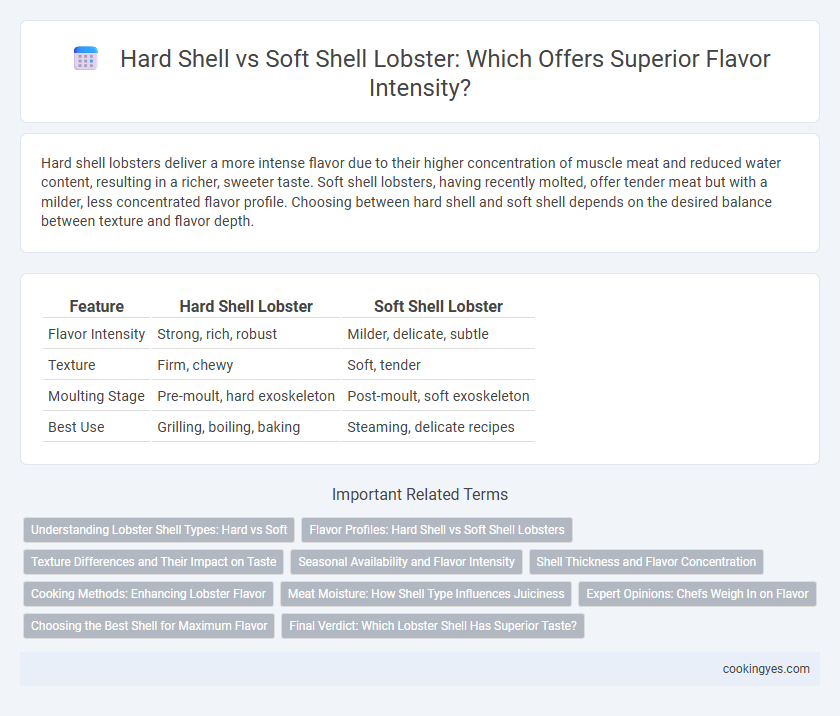Hard shell lobsters deliver a more intense flavor due to their higher concentration of muscle meat and reduced water content, resulting in a richer, sweeter taste. Soft shell lobsters, having recently molted, offer tender meat but with a milder, less concentrated flavor profile. Choosing between hard shell and soft shell depends on the desired balance between texture and flavor depth.
Table of Comparison
| Feature | Hard Shell Lobster | Soft Shell Lobster |
|---|---|---|
| Flavor Intensity | Strong, rich, robust | Milder, delicate, subtle |
| Texture | Firm, chewy | Soft, tender |
| Moulting Stage | Pre-moult, hard exoskeleton | Post-moult, soft exoskeleton |
| Best Use | Grilling, boiling, baking | Steaming, delicate recipes |
Understanding Lobster Shell Types: Hard vs Soft
Hard shell lobsters offer a more intense and robust flavor due to their dense, fully calcified exoskeleton which allows the meat to develop a firmer texture and richer taste. Soft shell lobsters, having recently molted and possessing a thinner, less calcified shell, provide a sweeter, more tender meat with a delicate flavor profile often preferred for subtle culinary applications. Understanding these shell types helps chefs and seafood enthusiasts select the ideal lobster based on desired texture and flavor intensity for their dishes.
Flavor Profiles: Hard Shell vs Soft Shell Lobsters
Hard shell lobsters typically offer a more intense and concentrated flavor due to their longer growth period, resulting in firmer meat with a slightly briny and sweet profile. Soft shell lobsters, having recently molted, present a milder and more delicate taste with a tender texture that absorbs seasoning more readily. The distinct difference in flavor profiles makes hard shell lobsters ideal for dishes highlighting robust, natural lobster taste, while soft shells complement recipes requiring subtlety and gentle flavors.
Texture Differences and Their Impact on Taste
Hard shell lobsters offer a firmer, denser texture that intensifies the natural sweetness and briny flavors, providing a meatier bite ideal for grilling or boiling. Soft shell lobsters, having recently molted, deliver a tender, more delicate texture that absorbs seasonings quickly, resulting in a subtler taste profile with a creamy mouthfeel. The texture differences between hard and soft shell lobsters directly influence flavor perception, with hard shells enhancing savory depth while soft shells emphasize smoothness and nuanced seasoning.
Seasonal Availability and Flavor Intensity
Hard shell lobsters, typically harvested in late summer and fall, offer a more intense and robust flavor due to their fully matured meat and firmer texture. Soft shell lobsters, found primarily during molting seasons in spring and early summer, deliver a sweeter but milder taste with a tender, delicate texture. Seasonal availability directly impacts flavor intensity, with hard shell lobsters favored for richer culinary applications during colder months.
Shell Thickness and Flavor Concentration
Hard shell lobsters boast a thicker exoskeleton that protects the meat, resulting in a denser texture and a more concentrated, robust flavor profile due to slower water absorption. Soft shell lobsters, recently molted and with a thinner shell, offer a sweeter, more tender taste but with milder flavor intensity, as their meat retains higher moisture levels. The shell thickness directly influences flavor concentration, making hard shell lobsters preferred for richer, more intense culinary experiences.
Cooking Methods: Enhancing Lobster Flavor
Hard shell lobsters offer a more intense, concentrated flavor due to their longer molting cycle, which allows meat to develop a firmer texture and richer taste. Soft shell lobsters, freshly molted, have a sweeter, more delicate flavor but less meat density, making them ideal for quick cooking methods like steaming or boiling to preserve tenderness. Grilling or broiling hard shells can enhance caramelization and depth of flavor, while gentle poaching soft shells prevents flavor loss and maintains their subtle sweetness.
Meat Moisture: How Shell Type Influences Juiciness
Hard shell lobster offers a more intense flavor due to its denser muscle fibers, which concentrate the natural sweetness of the meat. Soft shell lobster, recently molted, contains higher meat moisture, resulting in a juicier, more tender texture with a subtly milder taste. The increased water content in soft shell lobsters enhances succulence but can slightly dilute the robust flavor found in hard shell varieties.
Expert Opinions: Chefs Weigh In on Flavor
Chefs often emphasize that hard shell lobsters provide a more intense, concentrated flavor due to their denser meat and higher shell mineral content. Conversely, soft shell lobsters are praised for their tender texture and milder, sweeter taste, making them a favorite for delicate culinary dishes. Expert opinions highlight that the choice between hard and soft shell largely depends on the desired flavor profile and preparation method in gourmet recipes.
Choosing the Best Shell for Maximum Flavor
Hard shell lobsters deliver a more intense, concentrated flavor due to their lower water content and firmer texture, making them ideal for those seeking robust seafood taste. Soft shell lobsters, having recently molted, offer a sweeter, more delicate flavor but with a higher moisture content that can dilute the taste. Selecting the best shell depends on whether you prioritize bold, intense flavor (hard shell) or a tender, subtly sweet profile (soft shell) for maximum culinary enjoyment.
Final Verdict: Which Lobster Shell Has Superior Taste?
Hard shell lobsters offer a more intense, concentrated flavor due to their dense, firm meat and higher mineral content in the shell. Soft shell lobsters, recently molted, have sweeter, more delicate meat with a milder taste but less complexity. The final verdict favors hard shell lobsters for superior taste, prized by connoisseurs seeking robust and rich flavor profiles.
Hard Shell vs Soft Shell for flavor intensity Infographic

 cookingyes.com
cookingyes.com